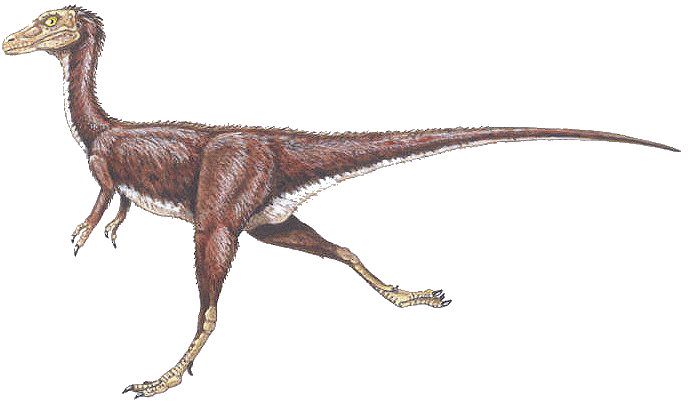|
Compsognathus
longipes (Wagner, 1859). |
|
 |
|
Compsognathus longipes -
without feathers |
 |
|
Compsognathus longipes -
with feathers |
|
Name Means: |
"Elegant Jaw" |
Length: |
3 feet (1 m) |
|
Pronounced: |
Komp-so-Nath-us |
Weight: |
6 pounds (3 kilos) |
|
When it lived: |
Late Jurassic 155 - 145 MYA |
|
|
|
Where found: |
Bavaria, Germany |
|
|
|
Compsognathus longipes was the first
reasonably complete dinosaur skeleton ever found. It was discovered in
the lithographic limestone of Solnhofen, Bavaria, by Dr. Oberndorfer in the late 1850's.
It was described and named by
Johann A. Wagner in 1859. The specimen was apparently a
juvenile, but even the adult form is not very large. Interestingly the
fossil skeleton of a small lizard,
Bavariasaurus, were found in the location of Compsognathus'
stomach.
his fossil is now on display at the Pale
ontological Museum in Oslo, Norway. A
second specimen was found in France. Although the French
specimen was originally described as a separate species,
Compsognathus corallestris, both it and the German specimen are
now thought to be Compsognathus longipes.
Archeopteryx, the early feathered reptile, which is now regarded as
the first bird, was found at the same site as the original
Compsognathus fossils at about the same time.
Compsognathus, with its many bird-like features, would shortly led
anatomists such as T. H. Huxley to propose a close affinity between
birds and dinosaurs. The discovery that Archaeopteryx
lived at about the same time at the same place would add considerable
weight to the argument.
Compsognathus was once the
smallest known dinosaur -- about the size of a chicken. It is hard to think of this little
creature as a real dinosaur, yet he is as much a dinosaur as big
Tyrannosaurs or giant Apatosaurus.Several
other dinosaurs are now known to have been smaller. They are
Microraptor, Parvicursor, and aenagnathasia
It only ran on its two back legs. A long tail acted as a
counterbalance and for stability during fast turns. Its shape
allows it to run fast and swiftly. This can help it to run from all
the predators. Because of its size and the
lightness of its bones, it is believed that Compsognathus was a very
swift predator.Its top speed has been estimated at twenty -five
miles per hour.
Compsognathus had a small, pointed head with small, sharp
teeth, hollow bones, and a long, flexible neck. It really
needed the sharp teeth because his head was about the size of
your palm, so it needed sharp teeth to help it chew and eat.
This little hunter probably ate bugs and the fossils preserved in its
stomach suggests that it ate small lizards.
It had short arms with either two
or three clawed fingers on each hand. There are only two known
fossils, and no bones of a third finger have been found. Some
paleontologists feel that, like the much larger Tyrannosaurus,
the little Compy had only two fingers. However, the hands are
disarticulated, which leads other paleontologists to suggest that it
had a third finger. It just hasn't been found.
so this is still uncertain. It appears that the bones are not
sufficiently preserved to make the determination. Others feel
strongly that it had three.
It is often argued that Compsognathus lacked
feathers, because none are preserved with either skeleton, while
Archaeopteryx, which was found in the same sediments, always
preserves feathers. However, the only feathers always preserved on
Archaeopteryx are the large ones on the wings and tail. The short
feathers which cover the body are rarely preserved. The discovery of ,
Sinosauropteryx, its only close has only has the short
kinds of feathers, so it's possible Compsognathus was feathered
too. |
|
|
|
|
|
|
|
|
Edugraphics.Net | Feenixx Publishing |
|
|
|
|
![]()

